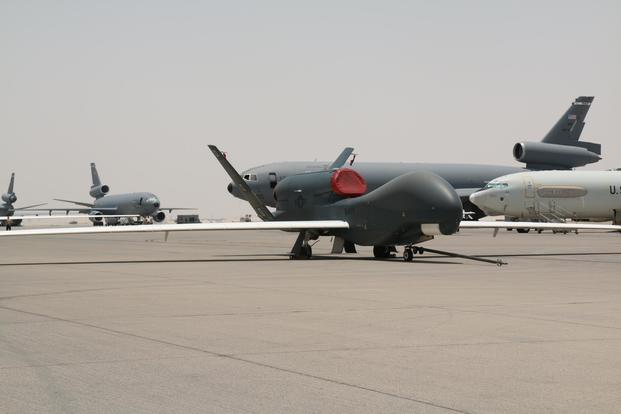SOUTHWEST ASIA - In the skies above Iraq and Syria, warfighters are achin' for some BACN: the communications relay, not the breakfast delight.
The Battlefield Airborne Communication Node payload, known as BACN, has become a lifesaver for broadcasting data to pilots flying in an increasingly contested environment, boosting their situational awareness for beyond-line-of-sight activity.
"The Global Hawk that does that up in Syria, we've got one airborne pretty much 24-7," Air Force Brig. Gen. Charles Corcoran, commander of the 380th Air Expeditionary Wing, told Military.com recently.
Military.com sat down with the commander at a base in an undisclosed location in the Middle East as part of a reporting trip to observe air operations against the Islamic State of Iraq and Syria, or ISIS.
Related content:
- The F-22 in Syria: Deconflicting, Not Dog-Fighting
- General: US Pilots Made the Call to Shoot Down Syrian Aircraft
- Why the F-22 Raptor Didn't Get the Air-to-Air Kill in Syria
BACN, developed by Northrop Grumman, is one Air Force effort to bridge the gaps between tactical data links that normally would not be able to transmit information to one another.
Corcoran described BACN as the service's "own personal cell tower, or a low altitude satellite."
The system is equipped on a few Global Hawk drones here in theater. The drones that carry BACN are Block 20 versions known as the E-Q4.
"It relays comm[unications], translates from one data link to another -- it allows us to extend the range of our [ultra high frequency] radios and [very high frequency] radios, and data link," Corcoran said.
"We fly that same comms package on business jets over in Afghanistan for the same purpose, E-11A Bombardier business jets ... we couldn't live without them," he said.
The base here has a handful of Global Hawks, also made by Northrop, some belonging to the U.S. Navy, and all Block 20, Block 30 and Block 40 upgraded variations, the general said.
"The Block 30 and Block 40 are the [intelligence, surveillance and reconnaissance] ones. They fly long [missions], I mean those things can fly," Corcoran said, referencing 24-hour or longer missions.
Block 30 works imaging and signals while Block 40 tracks radar and moving targets. Specifically, the Block 30 drones carry electro-optical, infrared, synthetic aperture radar (SAR), and high and low band SIGINT sensors, according to the Air Force. The Block 40 drones, meanwhile, house the radar technology insertion program (RTIP) active electronically scanned array radars, which provides moving target indicator data for time-critical targeting and SAR data.
In 2014, an RQ-4 Block 40 beat records when it flew a 34.3 hour flight, marking the longest unrefueled flight by an Air Force aircraft, according to the service.
Still, as the general described, the Block 20s with BACN have proved to be successful -- and in demand.
The Air Force wants yet another BACN-equipped Global Hawk. In May, the service awarded the Fall Church, Virginia-based defense company a $39.9 million contract to convert another RQ-4 into the EQ-4B, housing the BACN payload.
The project is expected to be complete by May 2018.










